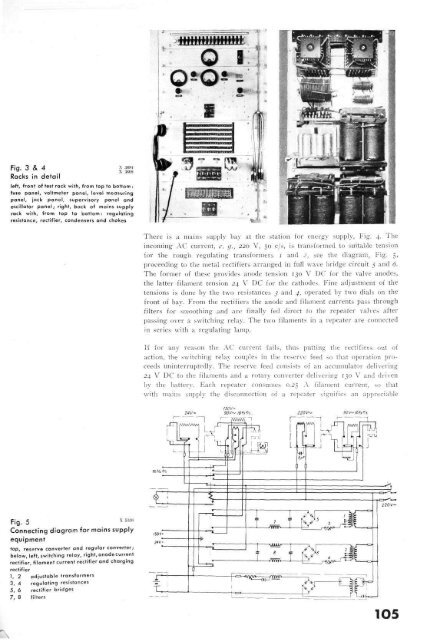contents - History of Ericsson - History of Ericsson
contents - History of Ericsson - History of Ericsson
contents - History of Ericsson - History of Ericsson
You also want an ePaper? Increase the reach of your titles
YUMPU automatically turns print PDFs into web optimized ePapers that Google loves.
Fiq. 3 & 4 x «<br />
Rocks in detail<br />
left, front <strong>of</strong> test rack with, from top to bottom :<br />
fuse panel, voltmeter panel, level measuring<br />
panel, jack panel, supervisory panel and<br />
oscillator panel; right, back <strong>of</strong> mains supply<br />
rack with, from top to bottom: regulating<br />
resistance, rectifier, condensers and chokes<br />
There is a mains supply bay at the station for energy supply. Fig. 4. The<br />
incoming AC current, c. g., 220 V, 50 c/s, is transformed to suitable tension<br />
for the rough regulating transformers I and 2, see the diagram, Fig. 5,<br />
proceeding to the metal rectifiers arranged in full wave bridge circuit 5 and 6.<br />
The former <strong>of</strong> these provides anode tension 130 V DC for the valve anodes,<br />
the latter filament tension 24 V DC for the cathodes. Fine adjustment <strong>of</strong> the<br />
tensions is done by the two resistances 3 and 4, operated by two dials on the<br />
front <strong>of</strong> bay. From the rectifiers the anode and filament currents pass through<br />
filters for smoothing and are finally fed direct to the repeater valves after<br />
passing over a switching relay. The two filaments in a repeater are connected<br />
in series with a regulating lamp.<br />
If for any reason the AC current fails, thus putting the rectifiers out <strong>of</strong><br />
action, the switching relay couples in the reserve feed so that operation proceeds<br />
uninterruptedly. The reserve feed consists <strong>of</strong> an accumulator delivering<br />
24 V DC to the filaments and a rotary converter delivering 130 V and driven<br />
by the battery. Each repeater consumes 0.25 A filament current, so that<br />
with mains supply the disconnection <strong>of</strong> a repeater signifies an appreciable<br />
105
















